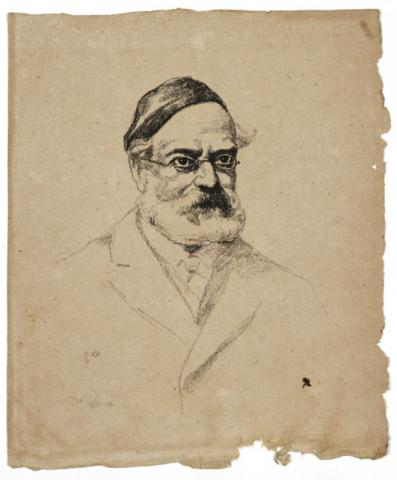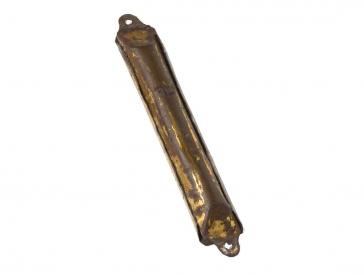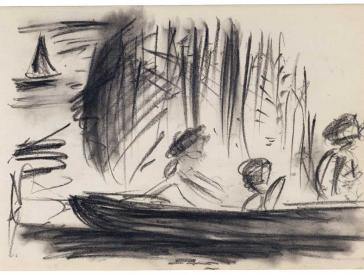
A Torah Curtain and Its Original Owner
What Provenance Research Revealed about This Object in Our Collection
With plenty of Hebrew text, clean lines, and barely any ornamentation, this Torah curtain leaves a spare and elegant first impression. It is made of heavy, dark-blue velvet with a large Star of David and a long Hebrew dedication embroidered on in radiant gold thread. In 1981, the Jewish department of the Berlin Museum acquired this Torah curtain as part of the Zwi Sofer Collection. Today it is held by the Jewish Museum Berlin. But who owned the Torah curtain originally?
The Hebrew Dedication
The Hebrew inscription on the Torah curtain itself tells us important information about the object’s history. Here is an English translation:
“Donated on behalf of G-d, presented as a gift to the eldest of the chavurah, our teacher and rabbi Rav Elchanan Gumpertz, may the Lord protect him and grant him long life, for his seventieth birthday; in gratitude for his great commitment, which he has shown for many years at the rabbinical seminary. From the board of the rabbinical seminary, 9th of Elul 5681 [12 September 1921].”
Thanks to this inscription, we know that the original owner of the Torah curtain was named Elchanan Gumpertz, that he was a scholar, turned 70 in 1921, and was deeply involved with a rabbinical seminary. On the basis of this very detailed information, the person in question could be identified unequivocally as Hermann Elchanan Gumpertz of Hamburg (1851–1938).
 X
X
Torah curtain; Jewish Museum Berlin, accession KGT 81/112/0, purchased with funds provided by Stiftung DKLB, photo: Roman März
The Torah Curtain’s Original Owner
Rabbi Hermann Elchanan Gumpertz was born in Frankfurt am Main. In 1879, he married Therese Treindel May in Hamburg, where he quickly made a name for himself. At age thirty-two, he was appointed to the board of the Association of Synagogues and was soon named its chair. He held many more offices and honorary roles: among others, he joined the Chief Rabbinate as an honorary dayan (rabbinic judge or rabbinical assistant) and later as a rabbinical administrative deputy (Rabbinatsverweser). He founded the Schass-Chewro (Talmud Society) and the Hamburg Association for Jewish History and Literature and co-founded the Jewish Literary Society. He was also a board member of the Alliance Israélite Universelle (literally the Universal Isrealite Alliance) and president of the Steinthal Lodge.
A Closer Look: The Steinthal Lodge in Hamburg
The Steinthal Lodge, founded in Hamburg in 1909, was dedicated to the motto of “charity, brotherly love, and harmony,” and had a largely affluent, upper-class Jewish membership. The Steinthal Lodge was part of the global network of B’nai B’rith Lodges (est. 1843), as indicated by the abbreviation "U.O.B.B." on the Bar Mitzvah medallion shown here, which stands for Unabhängiger Orden Bne Briss, or “Independent B’nai B’rith Order.”
Hermann Gumpertz was also involved at the national level and for many years was the chairman of the board of trustees of the Berlin Rabbinical Seminary. The “Rabbinical Seminary for Orthodox Judaism” was founded in October 1873 by Rabbi Esriel Hildesheimer in Berlin. The curriculum of this institution for training rabbis combined academic studies with the study of the Torah and Jewish sources. Its synagogue and classrooms were initially located at Gipsstraße 12a before being relocated to Artilleriestrasse 31–32 (on what is now Tucholskystrasse). The Rabbinical Seminary itself was housed on the ground floor of the building’s left wing; the seminarians prayed in the synagogue room known as the “Bachurim Shul,” located directly above it up one flight of stairs.
Hermann Gumpertz’s son Fritz Schalom Gumpertz, born in 1888, studied at the Berlin Rabbinical Seminary from 1910 to 1912 in addition to attending medical school in Heidelberg.
 X
X
Steinthal Lodge of Hamburg: bar mitzvah medallion; Jewish Museum Berlin, accession KGM 81/197/0, purchased with funds provided by Stiftung DKLB, photo: Jens Ziehe
A Key Document for the Provenance of the Torah Curtain
For his seventieth birthday, according to an article in the Allgemeine Zeitung des Judentums, a “porauches” (Torah curtain, in the traditional German-Jewish pronunciation for parochet) was gifted to Hermann Gumpertz and hung in his honor at the seminary synagogue in Berlin.
“Hamburg, September 23: Hermann Gumpertz, a distinguished figure among Germany’s observant Jewish community, celebrated his seventieth birthday. The man marking this milestone not only plays an active role in numerous community institutions but also sits on the board [...] of the Rabbinical Seminary of Berlin [...]. A notable presence on this special occasion was Rabbi Dr. M. Hildesheimer (Berlin), who, along with a delegation from the Rabbinical Seminary’s board, delivered a congratulatory address and presented a porauches destined to grace the seminary synagogue in Berlin in tribute to [Rabbi Gumpertz]. Other associations also gave addresses and presented commemorative gifts.”
(Article in the Allgemeine Zeitung des Judentums 85 [1921])
Unfortunately, the article does not describe the Torah curtain in detail, but it was most probably the same one now in the Jewish Museum Berlin’s collection.
Does a Gift Reflect the Recipient’s Personality?
Characterizations of Hermann Elchanan Gumpertz, both in articles from the period and descriptions by people who knew him, repeatedly emphasize his erudition and his humility.
“Hermann Gumpertz was well-versed in all areas of the Torah and secular education, belonging to an increasingly rare group of learned baalebatim [middle class people], who by serving as an example and role model inspired and encouraged people far and wide to embrace traditional, authentic observant Judaism, Torah teachings and their fulfillment and affirmation in life. And he did so with a self-assurance and straightforwardness that everyone admired in him.”
—P. [Anonymous]: “ Zum Heimgange Hermann Gumpertz” (On Hermann Gumpert’s Passing), in: Der Israelit 79 (1938) 33, p. 11. Translated to English for this website from the German.
Legend has it that Gumpertz was still teaching Talmud students from his deathbed just three days before his passing. At the end of the lesson, Gumpertz drifted out of consciousness, but he briefly revived two more times. The first time, he wanted to say kiddush, the blessing over wine on Shabbat. The second time, he asked for his tallit (prayer shawl) and his tefillin (prayer straps or phylacteries), which he put on, then died shortly thereafter.
Compared to other Torah curtains from the same period, which are sometimes richly decorated with multi-colored ornamentation or imagery, the matter-of-fact design and straight lines of Gumpertz’s Torah curtain stand out. This is probably an aesthetic reflection of its previous owner’s scholarly character.
Clues Lead Back to the Rabbinical Seminary
During the violence of 9–10 November 1938, still best known in English by the German euphemism Kristallnacht, the Berlin Rabbinical Seminary was forcibly closed by the Nazis. However, the Adass Yisroel Synagogue behind the seminary courtyard was spared and was neither desecrated nor destroyed.
It is known that a large portion of the Rabbinical Seminary’s library was successfully transferred to Israel. Likewise, Hermann Elchanan Gumpertz’s personal papers were mostly preserved and transferred to Israel. In 2017, a comprehensive collection of Gumpertz’s possessions was offered at an auction.
However, there are still some unanswered questions regarding the Torah curtain. Whether it was still located in the seminary synagogue during the terror of 9 November 1938, or its whereabouts in the intervening years, remain unknown.
Who was Hermann Gumpertz and What Became of Him?
Provenance researchers often delves deeply into the life stories of objects’ former owners. With that in mind, who was the man to whom this Torah curtain once belonged?
Hermann Elchanan Gumpertz was born on 6 September 1851 in Frankfurt am Main, where he attended the Hirsch Realschule (secondary school) and received a neo-Orthodox Jewish education in the tradition of Rabbi Samson Raphael Hirsch. His teachers included Rabbi Moshe Main and Rabbi Zalmen Posen in Frankfurt am Main as well as Rabbi Josef Dov HaLevi Bamberger in Würzburg.

Hermann Struck: Portrait of Samson Raphael Hirsch (1808–1888); Jewish Museum Berlin, accession 2007/98/0, photo: Jens Ziehe. You can find more information about this object in our online collections (in German).
 X
X
Hermann Struck: Portrait of Samson Raphael Hirsch (1808–1888); Jewish Museum Berlin, accession 2007/98/0, photo: Jens Ziehe. You can find more information about this object in our online collections (in German).
A Closer Look: Samson Raphael Hirsch and Neo-Orthodoxy
In the mid-nineteenth century, many Reform Jews were increasingly distancing themselves from longstanding customs and traditions. In contrast, Rabbi Samson Raphael Hirsch (1808–1888) sought to strengthen the faith as it had passed down and to ensure the observance of religious laws. He founded a stream of Judaism that became known as Neo-Orthodoxy. Beginning in 1851, he guided the Orthodox Israelitische Religionsgesellschaft (Israelite Religious Community) in Frankfurt am Main as its rabbi. With its big-city location, this community attempted to reconcile a German middle-class lifestyle with Orthodox piety. The community’s school, which Hirsch had founded in 1851 and Hermann Elchanan Gumpertz later attended, likewise aimed at pairing traditional Jewish education with the values of German idealism.
Hermann Elchanan Gumpertz’s father, the businessman Isaak Michael Gumpertz (1776–1861), died when his son was only ten years old. In the years that followed, his mother, Jettchen Gumpertz (née Stern), particularly encouraged her son’s education, both secular/commercial and religious. In part, he studied Torah with Chief Rabbi Josef Altmann in Karlsruhe, where he was also ordained as a rabbi.

Hermann and Therese Gumpertz (second and third from left) with other members of the May family; Jewish Museum Berlin, accession FOT93/506/0, gift of Shimshon S. Marcus
In May 1879, Hermann Gumpertz married Therese Treindel May in Hamburg. She was the daughter of Simon May, who came from a prominent and prosperous family of businesspeople in Hamburg. He was a cousin of Samson Raphael Hirsch and parness (community leader) of the Jewish Community in Hamburg.
The family has held onto a personal poem that was presumably written for Hermann and Therese Gumpertz’s wedding. The poem repeatedly invokes the word May, which was both the bride’s maiden name and the month of their wedding:
“What began today and tomorrow will be,
May it bask in happiness, and blessed may it be,
Long live this moment, in the future to stay,
For Therese and Hermann, an eternal May.”
 X
X
Gumpertz/May Family Tree; Courtesy of the Leo Baeck Institute, New York; Simon May Family, Hamburg, Collection AR159

Wedding Poem for Hermann and Therese Gumpertz; private collection of Esti Gumpertz
Hermann Elchanan Gumpertz died at the ripe old age of eighty-seven on 21 July 1938 in Hamburg. He was buried in a grave of honor at the Ohlsdorf cemetery, and a large memorial service was held at the Bornplatz synagogue. Numerous obituaries venerated his life and lasting impact. For example, Gumpertz’s obituary published in the weekly magazine Der Israelit on 18 August 1938 declares:
“In all his zeal for the Torah, he [also] had appreciation and love for art and science, for aesthetics and education, mastered languages ancient and modern, and knew how to combine the Torah with scientific education.”
—(P. [Anonymous]: “Zum Heimgange Hermann Gumpertz” (On Hermann Gumpert’s Passing), in: Der Israelit 79 (1938) 33, p. 11. Translated to English for this website from the German.
Just as Hermann Gumpertz’s papers and possessions eventually made their way to Israel, two of his children were also able to emigrate to Palestine/Israel before it was too late. Fritz Schalom Gumpertz became a well-known ENT doctor in Jerusalem. His sister Martha, born in 1861 and married to Hugo Bondi, emigrated to Palestine in 1940 via a roundabout route and settled in Haifa.
Anna-Carolin Augustin
Citation recommendation:
Anna-Carolin Augustin (2019), A Torah Curtain and Its Original Owner. What Provenance Research Revealed about This Object in Our Collection.
URL: www.jmberlin.de/en/node/6193
Behind the Scenes: Provenance Research at the JMB (4)




 X
X


 X
X





